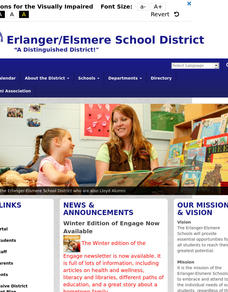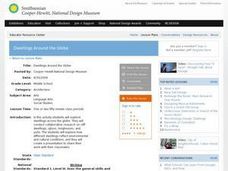Curated OER
Paragraph Development Exercise: Chronological Order
People use time to organize their days and structure their lives. Why not use it to structure a paragraph? Chronological order is logical and fairly straightforward. Ask class members to first read the provided example and then write...
Stanford University
Chronology: Civil Rights in the 20th Century
Test pupils' knowlege of history and the way civil rights movements unfolded using a series of images. With a primary source analysis activity, scholars practice their chronology and deductive reasoning skills. They use their knowledge...
University of Colorado
Astro-Chronology
Class members play a version of the game Chronology to determine when certain scientific events occurred in history. Teams play until someone has 5-10 events in the correct order.
Learn NC
A Christmas Carol Chronology
Which comes first? The Ghost of Christmas Past, Present, or Future? What clues can readers use to establish the chronology of A Christmas Carol? The tale of Ebenezer Scrooge, Marley, and Tiny Tim provides the text for an activity that...
For the Teachers
Story Strips Sequencing
What happens next? Work on story sequence with a lesson that prompts kids to put a story back in order. Additionally, they discuss what would happen if one event was missing from the sequence.
For the Teachers
Sequence Plot Chart
Your kids can identify the plot sequence of a short story, but what about an informational article? Have them examine the chronological order of events in informational texts with a lesson on the sequence of events.
Curated OER
Organizational Structures of Nonfiction Text/Graphic Organizers
Fifth graders review the characteristics of a nonfiction text. For this language arts lesson, 5th graders understand that one can use a specific graphic organizer to help them in understanding an organizational structure. For example, in...
Curated OER
Getting Your "Hands-On" a Great Outline
Students write with controlled and/or subtle organization. They learn three ways to arrange a formal outline. Students demonstrate this knowledge by creating an outline as class. They cover the concepts of anticipation, investigation,...
Curated OER
Beginning With Writing; Convey Ideas in Writing
Walk young writers through the process of creating an initial writing sample for their portfolio. They determine their purpose, organize their ideas, and then create a draft. The lesson includes worksheets and online resources to aid in...
Skyscraper Museum
Changes in a City Over Time
Investigate the growth and development of New York City with the final lesson in this four-part series on skyscrapers. Learners first explore the concept of urban growth by looking closely at a series of three paintings made of Wall...
Curated OER
Ancient Greece
Sixth graders examine the research that archaeologists have done on a Late Bronze Age shipwreck in order to work out the extent of trade in the Eastern Mediterranean during this period, with emphasis on the involvement of the Mycenaeans...
Curated OER
Folktales
Fourth graders read a Haitian folktale. They study main characters in Haitian folktales and explore multicultural information about Haiti. They clarify understanding by retelling a sentence (paraphrasing) and a passage in their own...
Curated OER
Narrative Writing
Students complete activities to learn narrative writing. In this narrative writing lesson plan students are given writing prompts in order to better understand how to write in a narrative format.
Curated OER
Recounts
In this language arts worksheet, students use the graphic organizer to review the concepts needed in order to write an individual account of a significant event.
Curated OER
Persuasive Letter about Smoking
Learners write a persuasive letter to someone they care about who smokes. They must use both logical and emotional appeals in their letter.
Curated OER
New York City Delights: The Taxi Cab
You set the rate! Step into the shoes of a taxi driver in New York City, and also pretend to be a person who uses taxis to get around town. The class will conduct collaborative research to learn about the history of taxis. Then, they...
Curated OER
The Paragraph
Review the components of a well-written paragraph with your class. Be sure your writers include a topic sentence supported with main ideas and followed by a conclusion. Unity, coherence, and transition words are emphasized. Experiment...
Curated OER
Paragraph Construction
What is a paragraph? This question drives the PowerPoint. Viewers discuss important elements of a solid paragraph, transitions between paragraphs, and strategies for editing. Show this presentation and then look at an example paragraph...
Curated OER
Where is the Trail? The Journey of Lewis and Clark
Students explore the trail followed by Lewis and Clark on their journey across the United States. In this United States History lesson, students complete several activities to establish the Lewis and Clark Expedition, including a class...
Curated OER
What is Diabetes?
Students examine basic information about diabetes and related vocabulary words. They explore various health websites, complete a worksheet, discuss the worksheet answers and discuss diabetes myths vs. facts.
Curated OER
Themes vs. Timelines
Teaching history through a thematic curriculum fosters a higher level of engagement and critical thinking in young historians.
For the Teachers
Cause and Effect Matrix
Study cause and effect in both literature and informational text with a lesson designed for several different reading levels. After kids review the concept of cause and effect, they read an article or story and note the causes and...
Curated OER
Islamic Art
Young scholars examine the various forms of Islamic Art. Using the art, they identify the basic elements and research its history and style of calligraphy. They create a piece of art based on information they collected and demonstrate...
Curated OER
Dwellings Around the Globe
Students explore dwellings around the globe and conduct collaborative research on cliff dwellings, igloos, longhouses, and yurts. They then explore how different dwellings reflect environmental and cultural conditions, and they create a...

























